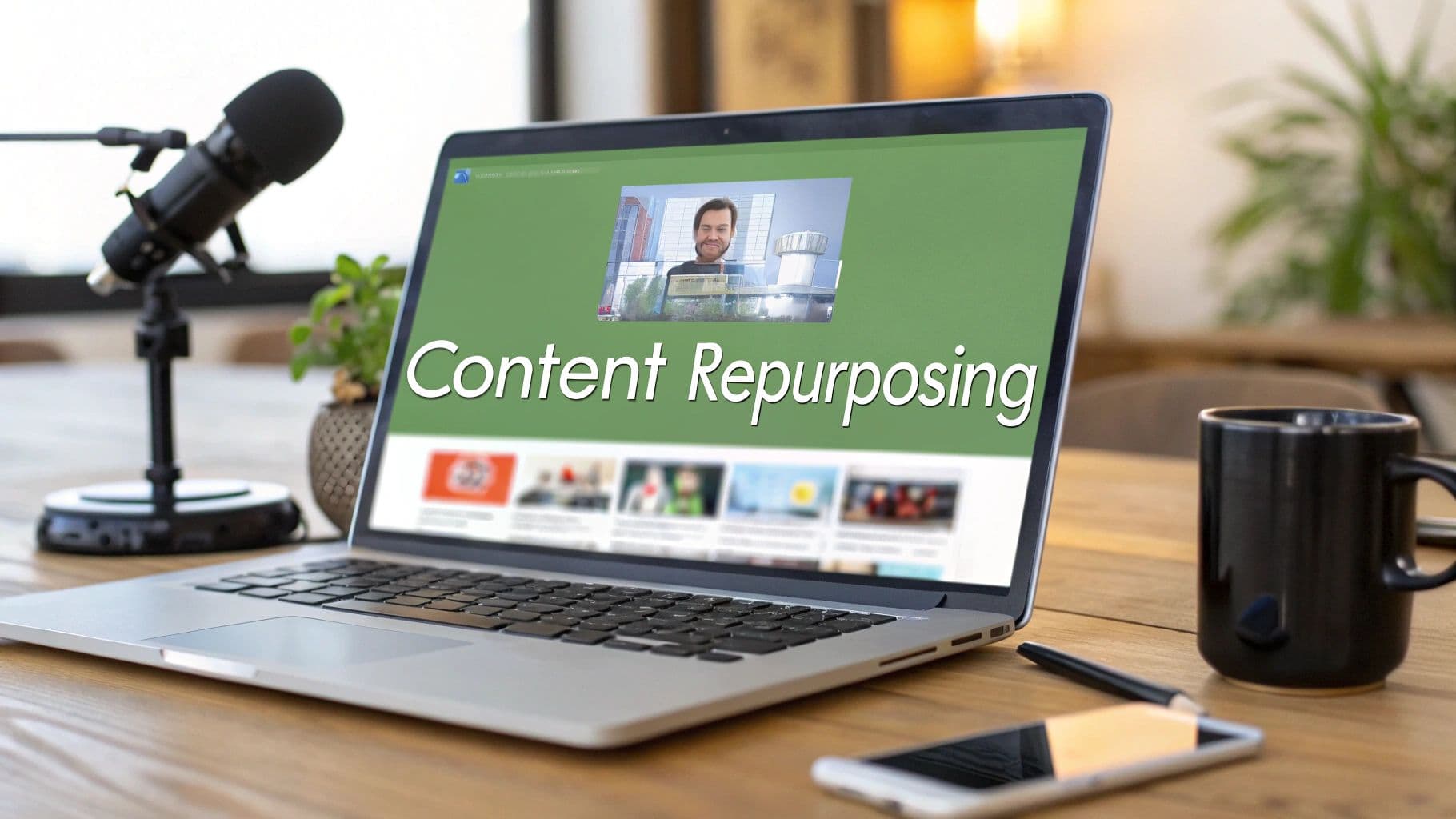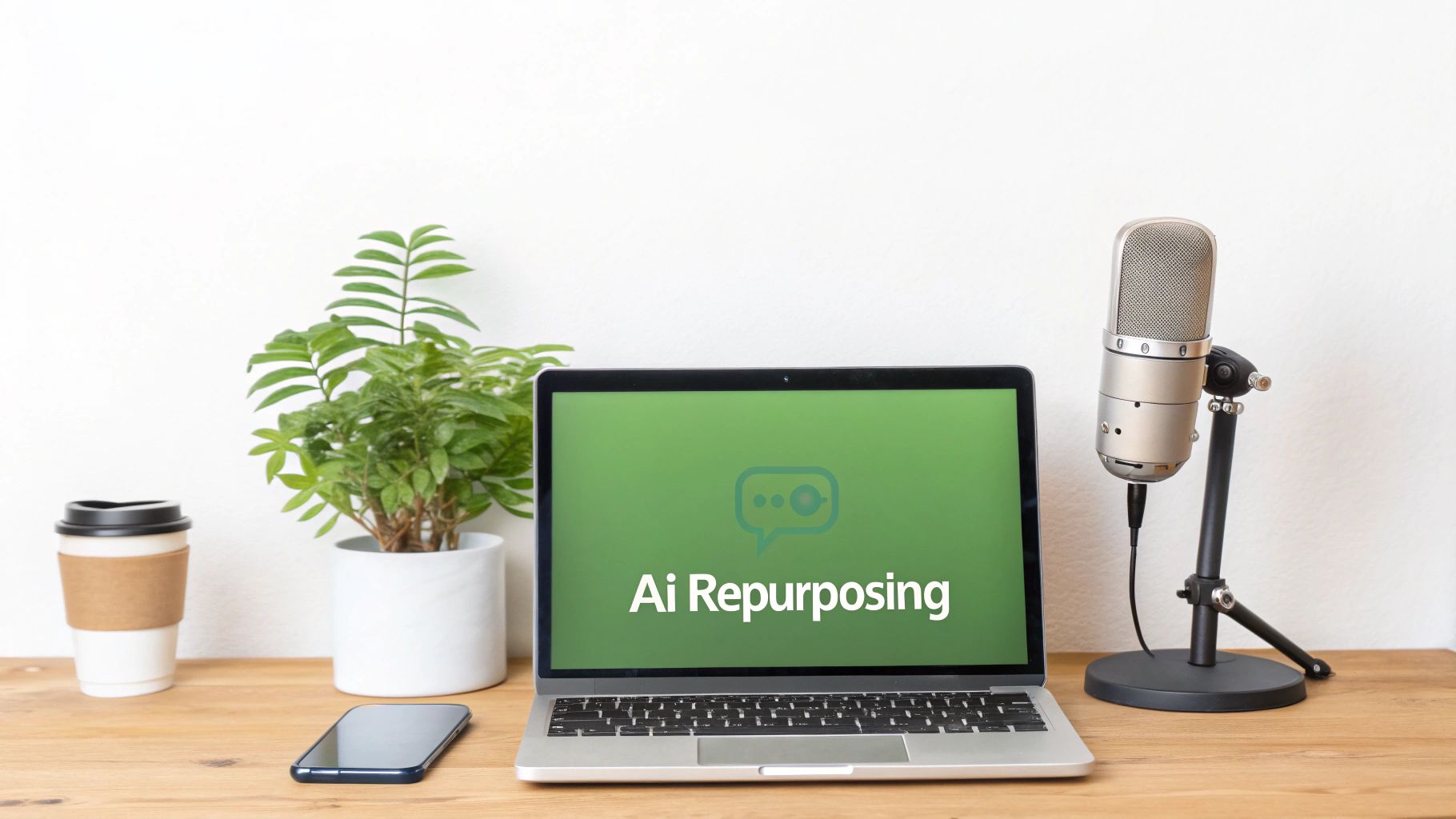
What Is Content Repurposing And How It Works
November 9, 2025
Stop staring at that blank content calendar. You don't always need a brand-new idea. The secret to a never-ending stream of content is likely hiding in something you've already created.
This is where content repurposing comes in. It’s the art of taking one killer piece of content and spinning it into multiple new formats to reach different people on different platforms. Instead of grinding away on the content treadmill, you’re strategically reusing your best work to get more mileage out of your initial effort.
What Is Content Repurposing, Really?

Think about a chef who roasts the perfect chicken. That one core dish can become chicken sandwiches for lunch, a hearty soup for dinner, and a savory pot pie for the weekend. Each meal is unique and appeals to a different craving, but they all started from the same place.
That’s exactly how content repurposing works.
It’s all about efficiency and impact. You take a big, valuable piece of content—maybe it’s a deep-dive blog post, a detailed webinar, or a data-packed report—and you find clever ways to adapt its core message. This isn't just copying and pasting. It’s a creative transformation.
Why This Strategy Is a Game-Changer
The goal here is simple: meet your audience where they already are, with the content formats they actually prefer. Some people love digging into a long article. Others would rather watch a quick video on their phone or listen to a podcast during their commute.
Repurposing makes sure your best ideas aren't stuck in a single format. And it works. A recent study found that a staggering 94% of marketers already repurpose content to expand their reach.
It just makes sense. You’re dramatically extending the life and value of your best work. A single great idea can fuel an entire multi-channel campaign, cementing your message and building your authority along the way.
The core principle is simple: Work smarter, not harder. Instead of being on a constant content treadmill, you multiply the value of your proven ideas, giving them new life and a much broader audience.
From One Idea to Many Assets
To really get the hang of it, check out a comprehensive guide to what content repurposing is and how it works. One core asset can genuinely fuel your content calendar for weeks, or even months.
For instance:
- A single blog post can be spun into an engaging infographic, a series of quick-tip videos for TikTok, and a handful of social media carousels for Instagram.
- A customer interview video can be transcribed into a compelling case study, with the best quotes pulled out for powerful Twitter posts.
The possibilities are endless. To show you what this looks like in practice, here’s a table breaking down how one core asset can be sliced and diced.
Core Content vs Repurposed Formats
| Core Content Asset | Potential Repurposed Formats |
|---|---|
| In-depth blog post or guide | Short-form videos, infographic, email newsletter series, social media carousel, podcast episode script |
| Webinar or live event | On-demand video recording, blog post summary, quote graphics, audio podcast, short highlight clips |
| Data-rich research report | Executive summary blog post, press release, shareable charts/graphs, webinar presentation, infographic |
| Podcast episode | Full-length YouTube video, blog post with transcript, social media audiograms, short quote clips, email newsletter |
| Video interview | Case study or success story, blog post highlighting key takeaways, quote graphics, short video clips for social |
As you can see, you’re not just re-posting the same thing everywhere. You’re giving your audience fresh, valuable, and format-appropriate ways to engage with your best ideas.
The Strategic Benefits Of Repurposing Content
Sure, repurposing content saves you time, but that's just scratching the surface. The real magic is in its strategic impact. Think of it as a force multiplier for your marketing—you take one great piece of content and amplify its value across your entire digital footprint. It’s way more than just being efficient; it’s a smart way to grow your audience, build authority, and get noticed by search engines.
Every time you repurpose a piece of content, you’re essentially opening a new door for people to find your brand. The person who loves listening to podcasts on their commute probably won't see your in-depth blog post. And the audience scrolling through Instagram carousels might never sit through your hour-long webinar.
Repurposing closes those gaps. It makes sure your core message gets to more people, in the formats they actually want to consume.
This approach is also a huge win for modern SEO. When you turn a massive pillar blog post into a bunch of different formats—videos, infographics, social media threads—you create a whole network of interconnected content. Each piece can rank for different keywords, and they all link back to your main asset, which tells Google that your original content is a big deal.
Maximize Your Marketing Reach
By adapting your best stuff, you're not just recycling ideas. You're strategically introducing them to entirely new audiences. You already know the concept works with one group, so repurposing gives you a much better shot at success on other channels.
Think about all the different ways you can reach people:
- Video Converts: That deep-dive article can become a short, snappy YouTube video. This is perfect for the 66% of people who'd rather watch a video to learn about a product or service.
- Podcasts Engage: You can strip the audio from a webinar or video interview and publish it as a podcast episode, reaching listeners on platforms like Spotify and Apple Podcasts.
- Visuals Stick: Key stats and takeaways from a dense report can be turned into a super-shareable infographic. These are gold on visual platforms like Pinterest and LinkedIn.
Boost Authority And ROI
When you consistently show up across different platforms with valuable insights, you start to look like an expert. If a potential customer sees your message reinforced in a blog post, then again in a social media clip, and later hears it on a podcast, it builds serious trust. You become the go-to authority in your field, and that keeps you top-of-mind.
Repurposing fundamentally changes your content ROI. Instead of a "one-and-done" approach, you invest once in creating a high-value asset and then reap the benefits multiple times over as you adapt it for new channels.
The scale of this is massive. The global content marketing industry is valued at around $564.8 billion and is expected to nearly triple by 2032. Repurposing is how you get the most out of that investment. It’s a no-brainer, especially when you consider that formats like infographics are 30 times more likely to be read than a plain text article. If you want to dive deeper into the data, check out these insightful content marketing statistics and trends.
How To Find Your Best Content To Repurpose
So, where do you start? Not every blog post or video you've ever made is a good candidate for repurposing. The real magic happens when you're selective. Instead of just guessing what might work, let the data show you which pieces are already pulling their weight.
The best place to begin is your own analytics. You're looking for the quiet champions—the content that performs well on its own, long after you've stopped actively promoting it. These are the assets that consistently bring in traffic, keep people reading, and even generate leads.
Identify Your Evergreen Performers
Your strongest contenders for repurposing are almost always your evergreen articles. These are the timeless heavy-hitters that stay relevant year-round because they solve a core problem or answer a fundamental question for your audience. They aren't tied to a fleeting trend.
You can spot them by looking for a few key signals:
- Sustained Traffic: Check your analytics for posts that pull in consistent organic search traffic over months, not just days.
- High Engagement: Look for a high time-on-page, a low bounce rate, or a healthy number of shares and comments. People are sticking around for a reason.
- Strong Backlinks: If other credible sites are linking to your content without you asking, that’s a huge vote of confidence. It’s a clear sign of value.
These metrics tell a story about what your audience truly cares about. Getting comfortable with this data is a game-changer, and you can dive deeper into measuring content effectiveness to really sharpen your skills.
Pinpoint Pillar Posts and Customer Favorites
Another goldmine? Your pillar content. These are the massive, in-depth guides that cover a big topic from top to bottom. Because they are so packed with information, they are practically begging to be sliced and diced into smaller, more focused pieces. A single pillar post can easily become the source material for a dozen smaller assets.
Think of a pillar post as the "roast chicken" of your content strategy. It's the main meal, sure, but the leftovers can be turned into countless other dishes—videos, infographics, social media threads, and more.
Finally, don't forget to listen. Talk to your sales and support teams. What articles do they send to customers all the time? Which blog posts solve the most common problems or answer the most frequent questions? Content that directly addresses a customer's pain point is incredibly valuable and ripe for a refresh into new formats.
When you start with these proven winners, you're building your repurposing efforts on a foundation that's already solid.
Effective Content Repurposing Pathways And Ideas
Knowing what content to repurpose is only half the job. The other half is knowing how to transform it. The best strategies aren't just about copying and pasting; they follow clear pathways that turn one big asset into a whole collection of content, each piece perfectly suited for different platforms and audiences.
Think of a big, comprehensive blog post as your command center. From that single source, you can branch out in all sorts of directions, creating smaller, targeted pieces designed to meet your audience right where they are. The trick is to reformat the core message, not just repeat it.
From Blog Post To Multi-Channel Campaign
A single, well-researched article has enough fuel to power your content calendar for weeks. The idea is to slice it up, breaking down the key concepts into smaller, more digestible formats that feel native to other platforms. A Semrush report even found that 42% of marketers saw success simply by repurposing content they already had.
Here are a few proven pathways:
- Spin it into an Infographic: Pull out the most important stats, steps, or takeaways and turn them into a sharp, shareable infographic. This is gold for visual platforms like Pinterest and LinkedIn.
- Turn it into a Video Script: Use the main sections of your blog post as a script for a quick YouTube or Loom video. You can walk people through the concepts visually instead of making them read.
- Craft a Week of Social Posts: Lift powerful quotes, surprising stats, or actionable tips to create a whole series of posts for Instagram, X (formerly Twitter), or Threads.
This infographic breaks down how a pillar page can become a goldmine for finding evergreen topics, answering common questions, and pulling out key data.

As you can see, your best candidates for repurposing—timeless concepts, frequently asked questions, and hard data—are usually already tucked away inside your most in-depth content.
Expanding Your Content's Reach
Don't just stick to static posts. Think about more dynamic formats, too. The audio from a webinar, for example, can easily become a podcast episode for the crowd that prefers to listen on their commute. As you brainstorm, exploring effective evergreen streaming ideas can spark inspiration for adapting your best content into live or on-demand video.
Key Takeaway: The goal isn't to just republish the same thing everywhere. It’s about re-imagining your content for the unique vibe and user behavior of each platform, making sure your message hits home no matter how someone finds it.
Here’s another idea: bundle a few related blog posts together into a downloadable e-book or a short email course. Boom—you’ve just created a high-value lead magnet. You can find even more inspiration by checking out these social media content ideas, many of which can be pulled from a single core article.
Every new format you create acts as a new doorway, guiding people back to your core content and building your authority along the way.
Content Repurposing Transformation Matrix
To make this even clearer, I've put together a quick-reference table. Think of it as a cheat sheet for turning one type of content into another, helping you decide where to focus your efforts.
| Original Content Type | Best Repurposing Options | Target Platform |
|---|---|---|
| Long-Form Blog Post | Infographics, Short Videos, Social Media Snippets, E-book | LinkedIn, Pinterest, YouTube, Instagram |
| Webinar/Video | Podcast Episode, Blog Post Summary, Quote Graphics, Clips | Spotify, Apple Podcasts, Blog, X/Threads |
| Podcast Episode | Audiograms, Blog Post with Transcript, Newsletter, Carousels | Instagram, Blog, Email, LinkedIn |
| Case Study/Data Report | Infographic, Press Release, Webinar, Social Media Stats | Social Media, PR Outlets, YouTube |
This matrix isn't exhaustive, but it covers the most common and effective pathways. Use it as a starting point to see how your best-performing assets can get a second, third, or even fourth life on a new platform.
Using AI for Smarter Content Repurposing

Manually adapting your content for different platforms is a grind, but artificial intelligence is changing the entire equation. AI tools have evolved into strategic partners, making the whole repurposing workflow faster, smarter, and way more efficient.
Instead of spending hours trying to boil down a blog post for social media, AI can pull out the key points and whip up compelling little updates in seconds. This isn't about replacing human creativity. It’s about augmenting it—letting the machine handle the repetitive heavy lifting so you don't have to.
AI-powered repurposing is quickly becoming a go-to strategy for businesses trying to get more mileage out of their work. These tools slash the time and cost of content creation by quickly spinning a single asset into multiple formats. It also helps lock in consistent messaging by automatically sticking to your brand identity, which is a huge factor for audience recognition. On top of that, you get data-driven insights to help shape future content. You can read more about the impact of AI on content repurposing strategies.
How AI Streamlines the Repurposing Workflow
Think of AI as a highly skilled assistant that can execute specific tasks with incredible speed. It’s fantastic at transforming content from one format to another, opening up possibilities that were once just too time-consuming to even think about.
For instance, AI can:
- Generate Video Scripts: Instantly turn a detailed article into a structured video script, complete with scene suggestions and talking points.
- Create Audio Versions: Convert written content into natural-sounding audio, making it dead simple to launch a podcast episode from a popular blog post.
- Summarize for Brevity: Condense a lengthy report or webinar into bullet points perfect for an email newsletter or a quick LinkedIn post.
The real magic of AI here is its ability to handle the structural transformation of content. It frees you up to focus on the creative touches, the strategic oversight, and making sure the final product actually connects with your audience.
One of the trickiest parts of repurposing is keeping a consistent brand voice. Advanced AI tools can be trained on your existing content to learn your specific tone, style, and jargon. This ensures every new asset sounds authentically like you. If you're new to this, you can check out our guide on how to use AI to rewrite text to nail down your unique voice.
Common Repurposing Mistakes You Should Avoid
Repurposing content is a fantastic shortcut, but it's not foolproof. A few common mistakes can easily derail your efforts, turning a smart strategy into a complete waste of time. If you know what to watch out for, you can make sure every repurposed asset actually works for you.
The biggest mistake I see? Treating repurposing like a simple copy-and-paste job.
Just dropping a blog post link on X or sharing a YouTube video on LinkedIn without any context is a recipe for crickets. Every platform has its own vibe and audience expectations. What works one place will feel jarring and out of place somewhere else unless you adapt it.
Another major misstep is picking the wrong content to start with. You can't breathe new life into something that was dead on arrival.
Starting with the Wrong Foundation
Choosing your source material is half the battle. If you start with a weak piece of content, all you're doing is spreading mediocrity across more channels.
Here’s what you should absolutely avoid repurposing:
- Poorly Performing Content: If an article got zero traffic and no engagement, there's a reason. Repurposing it won't magically make people care.
- Time-Sensitive News: An article about a fleeting trend or a news story from six months ago has a very short shelf life. Stick with your evergreen content—the stuff that’s always relevant.
- Thin or Low-Value Posts: If a post doesn't offer real insight or solve a genuine problem for your audience, it's not worth the effort to reformat.
The whole point of repurposing is to amplify your greatest hits, not to resuscitate your flops. Always, always start with a proven winner that has already connected with your audience.
Overlooking Promotion and Quality
Finally, two other blunders can sink your whole strategy. First up is sacrificing quality for quantity. Pushing out ten low-effort, half-baked assets is way less effective than creating two high-quality, thoughtfully adapted pieces. Each repurposed item should feel like it was made specifically for that platform.
The second mistake is forgetting to actually promote your new assets. Just because the core content isn't brand new doesn't mean your audience will automatically find it. Every new piece—whether it's an infographic, a video clip, or a carousel—deserves its own promotional push to get the eyeballs it needs to succeed.
Of course. Here is the rewritten section, crafted to sound completely human-written and natural, following the style of the provided examples.
Frequently Asked Questions About Content Repurposing
Even with a solid plan, you're going to have questions. Once you start digging into what is content repurposing, practical concerns about things like SEO, timing, and results always come up. Let's tackle the big ones so you can move forward with confidence.
One of the first hurdles I see people worry about is duplicate content. Will Google penalize you for putting similar ideas out there in different formats?
The short answer is no—not if you're smart about it.
Repurposing isn't about copy-pasting. It’s about adapting an idea for a totally new platform, and search engines get that. A video script and a blog post might share the same core message, but they're fundamentally different pieces of content.
How Do I Handle SEO for Repurposed Content?
Your main goal here is to avoid confusing search engines. You don't want your new assets competing against your original pillar piece for the same keywords. You want them to support it.
To pull this off, just follow a few best practices:
- Use Canonical Tags: If you republish a blog post somewhere else, like on Medium or LinkedIn, use a canonical tag. It’s a simple line of code that points back to your original article, telling Google, "Hey, this is the main version."
- Link Back to the Original: Always, always link from your repurposed assets—videos, infographics, social posts—back to the main pillar content. This builds a strong internal linking web and signals to search engines that your original piece is the authority.
- Target Different Keywords: Tweak the optimization for each new piece. Your repurposed content should go after different, more specific long-tail keywords. A YouTube video might target "how to repurpose a blog post," while the original article is aimed at the broader "what is content repurposing."
How Often Should I Repurpose Content?
There’s no magic number here. A good rule of thumb is to start with your best-performing, evergreen content. A single high-value pillar post can easily fuel your content calendar for a whole month—spawning a video, an infographic, and a week’s worth of social media updates.
Don’t get hung up on a strict schedule. Let your content's performance and your campaign goals be your guide. When a piece is still getting steady engagement and traffic, it's a perfect candidate for another round of repurposing.
How Can I Measure the Success of My Efforts?
Measuring the ROI of repurposed content means looking beyond a single metric. You need to see how each new asset is contributing to your bigger goals.
Start by tracking a few key things for each repurposed piece:
- Traffic and Referrals: How much traffic is the new asset sending back to your core content or website?
- Engagement Rates: Look at likes, shares, comments, and views for each format on its home platform.
- Lead Generation: If you turned a blog post into a downloadable checklist, how many new leads did it bring in?
By keeping an eye on these individual metrics, you’ll start to see which repurposing pathways deliver the most bang for your buck. That's how you make smarter decisions next time.


